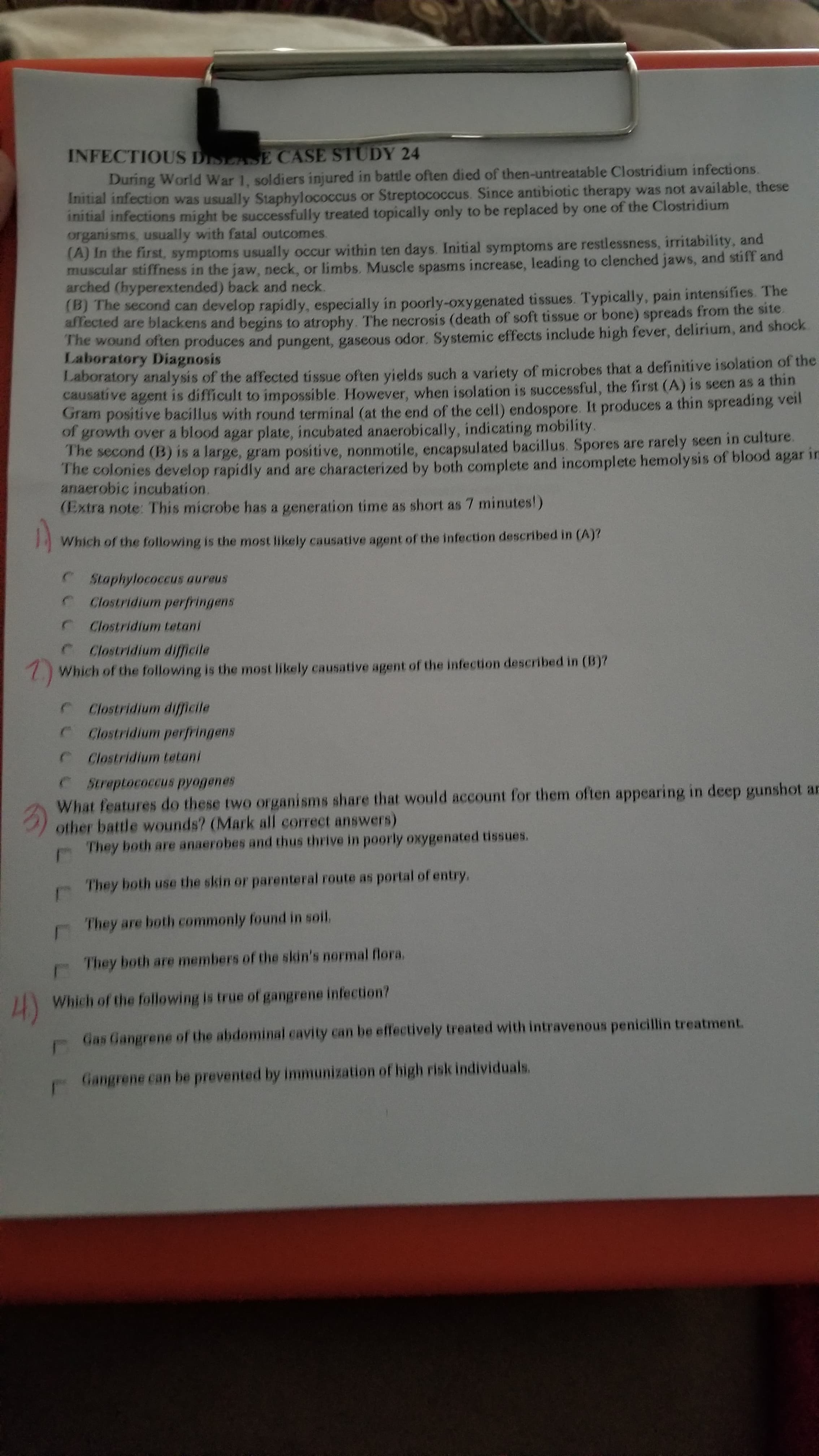INFECTIOUS DISEASE CASE STUDY 24 During World War 1, soldiers injured in battle often died of then-untreatable Clostridium infections. Initial infection was usually Staphylococcus or Streptococcus. Since antibiotic therapy was not available, these initial infections might be successfully treated topically only to be replaced by one of the Clostridium organisms, usually with fatal outcomes. (A) In the first, symptoms usually occur within ten days. Initial symptoms are restlessness, irritability, and muscular stiffness in the jaw, neck, or limbs. Muscle spasms increase, leading to clenched jaws, and stiff and arched (hyperextended) back and neck. (B) The second can develop rapidly, especially in poorly-oxygenated tissues. Typically, pain intensifies. The allected are blackens and begins to atrophy. The necrosis (death of soft tissue or bone) spreads from the site. The wound often produces and pungent, gaseous odor. Systemic effects include high fever, delirium, and shock. Laboratory Diagnosis Laboratory analysis of the affected tissue often yields such a variety of microbes that a definitive isolation of the causative agent is difficult to impossible. However, when isolation is successful, the first (A) is seen as a thin Gram positive bacillus with round terminal (at the end of the cell) endospore. It produces a thin spreading veil of growth over a blood agar plate, incubated anaerobically, indicating mobility. The second (B) is a large, gram positive, nonmotile, encapsulated bacillus. Spores are rarely seen in culture. The colonies develop rapidly and are characterized by both complete and incomplete hemolysis of blood agar anaerobic incubation. (Extra note: This microbe has a generation time as short as 7 minutes!) in Which of the following is the most likely causative agent of the infection described in (A)? Staphylococcus aureus C Clostridium perfringens C Clostridium tetani C Clostridium difficile 7) Which of the following is the most likely causative agent of the infection described in (B)? C Clostridium difficile CClostridium perfringens C lostridium tetani CStcreptococcus pyogenes What features do these two organisms share that would account for them often appearing in deep gunshot an other battle wounds? (Mark all correct answers) They both are anaerobes and thus thrive in poorly oxygenated tissues. 3) They both use the skin or parenteral route as portal of entry. They are both commonly found in soil. They both are members of the skin's normal flora. Which of the following is true of gangrene infection? Gas Gangrene of the abdominal cavity can be effectively treated with intravenous penicillin treatment. Gangrene can be prevented by immunization of high risk individuals.
Bacterial Genomics
The study of the morphological, physiological, and evolutionary aspects of the bacterial genome is referred to as bacterial genomics. This subdisciplinary field aids in understanding how genes are assembled into genomes. Further, bacterial or microbial genomics has helped researchers in understanding the pathogenicity of bacteria and other microbes.
Transformation Experiment in Bacteria
In the discovery of genetic material, the experiment conducted by Frederick Griffith on Streptococcus pneumonia proved to be a stepping stone.
Plasmids and Vectors
The DNA molecule that exists in a circular shape and is smaller in size which is capable of its replication is called Plasmids. In other words, it is called extra-chromosomal plasmid DNA. Vectors are the molecule which is capable of carrying genetic material which can be transferred into another cell and further carry out replication and expression. Plasmids can act as vectors.
Question 2

Trending now
This is a popular solution!
Step by step
Solved in 3 steps








